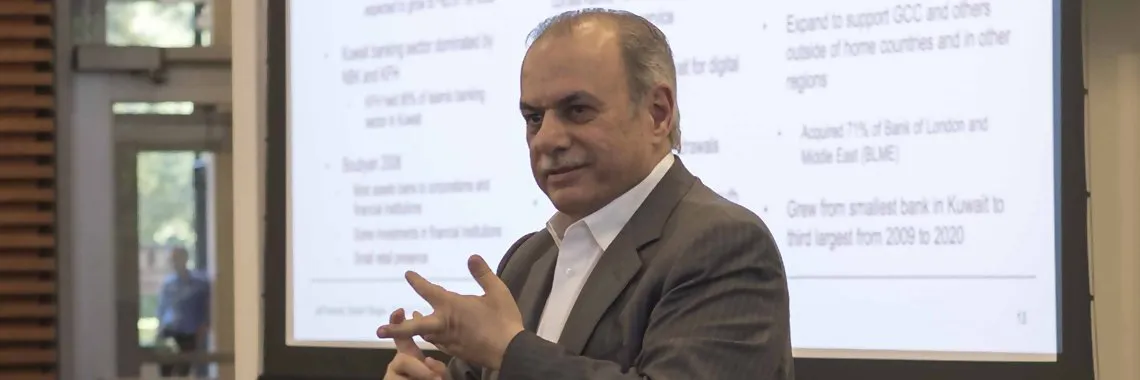
Boubyan Bank’s Group Chief Executive Officer Gives a Lecture at Stanford Graduate School of Business on Secrets of Successful Leadership
Boubyan Bank, an Example of a Success Story That Required a Lot of Work & Effort Amid a Highly Competitive Market. The Bank Is Now a Case Study Taught at Universities
Al-Majed’s Lecture Complemented the Study of the Kuwaiti MBA Graduate, Laila Al-Jasem
Al-Majed: Assembling the Right Executive Team to Lead The Bank’s Transformation Is One of the Main Reasons Behind Boubyan Bank’s Successes and Achievements
In Less Than 10 Years, Boubyan Moved to The Third Place Up from the Ninth Domestically
Al-Majed: The Bank’s Management Still Has High Ambitions to Be Among The World’s Top Five Islamic Banks
Boubyan Bank represents a unique success story of an institution rising steadily towards the top to assume an outstanding place in the banking industry and at the level of Islamic banking, regionally and internationally, especially in the digital services domain. This drove Stanford Graduate School of Business to invite Boubyan Bank’s Vice-Chairman & Group Chief Executive Officer, Mr. Adel Abdul Wahab Al-Majed, to give a lecture to MBA students, thus becoming one of the most prominent leaders who were invited to give lectures; this included the CEOs of major companies such as Ford, Johnson & Johnson, Lyft, and AT&T.
Al-Majed’s lecture came as a part of “System Leadership” module to complement the study prepared by the Kuwaiti MBA Program Graduate, Ms. Laila Al-Jasem, under the supervision of Lecturer Robert Siegel who, along with Jeffrey Immelt (who served as CEO of General Electric for 16 years), supervise this module where Al-Majed participated, and which is one of the most popular modules among MBA students at Stanford University, which is ranked first in MBA studies in the United States.
** The 2009 Start
During the lecture, Al-Majed reviewed the start towards restructuring the bank in 2009 as he assumed the CEO position, backed by his long experience with NBK, and how he started assembling a team of outstanding leaders who occupied various positions over the years in the Kuwaiti banking sector.
“Over a few years, we managed to achieve double digit growth every year across many important financial metrics. By 2020, Boubyan had the second-highest number of Kuwaiti customers and had gone from the smallest Banks a solid number three. Boubyan became a formidable force to contend with in Kuwait’s banking sector.”, Al-Majed added.
Al-Majed went on describing such achievements: “After 12 years of transformation, Boubyan Bank’s Group now has 3 banks; Boubyan, BLME and NOMO digital bank, in addition to a Takaful insurance company, an investment company, and a services’ company.”
“Reaching to where we are in 2021 specifically was not easy; however, we can summarize the reasons behind our success in some points, the most important of which are setting up a clear strategy, assembling an experienced executive team, returning to the basics of business banking, focusing on customer service, investing in digital banking services, investing in our human resources, and focusing on national cadres.”
** Boubyan Bank Amid The 2008 Global Crisis
Boubyan Bank was incorporated in 2004, and started doing actual business in the next year in light of the fierce competition, and then came the financial crisis of 2008 which affected various sectors of the Kuwaiti economy, especially in the banking and financial sectors.
In 2009, the National Bank of Kuwait acquired a major stake in Boubyan Bank, and continued a series of acquisitions in Boubyan which currently stands at 60% approximately. This change brought Al-Majed to Boubyan, with his 30 years of experience at NBK back then.
Speaking about this step, Al-Majed stated: “When the opportunity came to join Boubyan, I thought to myself, ‘Right now, I’m number three or four at NBK and it will likely stay that way. I’ve plateaued in my career. Let me accept the challenge and go to Boubyan for a chance to build my own legacy.’ But I resolved to do things differently and to build a team culture. I was also convinced there was a huge growth opportunity for Islamic banks.”
In August 2009, Al-Majed left his post at NBK to take the reins as CEO of Boubyan Bank. About 30 minutes into his new role, Al-Majed walked into Boubyan Bank’s head office. He noticed a device by the entrance and asked what it was. The answer, he recalled, was that “It’s a fingerprint processor to keep track of employees’ attendance.” “Please take it down—it’s no longer needed. I evaluate people based on performance.” Al-Majed responded, signaling an imminent change in workplace culture.
As he walked a little further into the head office, he noticed what was designated the “CEO’s elevator.” Within minutes, he requested the elevator be open for everyone’s use. Reflecting on his first two decisions, Al-Majed explained his management style: “To be reachable and trusting yet hold people accountable.”
Ever since the beginning Al-Majed laid out his vision for Boubyan’s retail presence as he stated: “I looked at our main competitors in the sector of Islamic financial services in Kuwait, and concluded that they rely on their Islamic identity; however, they have weaknesses in customer service. Hence, I thought if we could offer excellent service and give customers everything they got from conventional banks (products, services, experience) and add an Islamic flavor to it, maybe we can become the bank of choice.”
** Assembling The Team
The wind of change continued at the bank’s management level as Al-Majed started assembling his team which was joined later on by many executives who were former colleagues of his, led by Mr. Abdullah Al-Tuwaijri who joined as a Deputy CEO - Retail Banking Services, and Mr. Abdul-Salam Al-Saleh as Deputy CEO, Corporate Banking Services.
Al-Majed dwelt on the most prominent steps taken: “When applying their judgment, some banks take a less conservative approach. But the bravest thing we did was taking USD 234 million in provisions, more than three times higher than the prior year. By January 2010, we had a healthy bank from a balance sheet perspective. We still had other issues - services, products, systems - but it was a cleaner balance sheet and a new management team capable of starting a new journey.”
As per a preliminary study conducted by the bank back then, 10 to 15 percent of Kuwaitis were extremely liberal who somehow avoided Islamic banks. A similar percentage were extremely religious and would only bank with Islamic banks. However, the remaining vast majority of the population was just conservative and open to dealing with an Islamic bank for sure but not at the expense of services, products, and innovation.
Increasing the Number of Branches and Digital Services
A study by Stanford University MBA Program Graduate, Ms. Laila Al-Jasem shows that Boubyan Bank only had 10 branches in 2009 when Al-Majed took a decision to expand the bank’s network while stating: “For the past eight years, our competitors said, ‘The future is digital.’ And I agreed, the future is digital. But I’m not going to wait around for customers to change. While most banks were closing branches, we were opening new ones.”
The study quotes Al-Majed: “We realized we had a very solid IT team. We started giving them more incentives and freed them up from the routine parts of their jobs. I gave the technical team full freedom to develop products. This is unusual in traditional banking.”
All the bank’s key financial indicators demonstrate the results of the efforts exerted by Al-Majed and his team, which started showing early by the end of 2010. Less than two in years into the turnaround, the bank’s financing portfolio had shifted, and it grew by over 73 percent, from $1.6 billion in 2008 to $2.7 billion in 2010.
From 2010 to 2021, the retail financing portfolio - that accounted for a modest percentage in 2008’s financing portfolio - represented 42 percent of the financing portfolio at $7.9 billion in 2021 (a 3-fold increase over seven years at a compounded annual growth rate of 17%). Corporate financing more than doubled between 2008 and 2021 to $10.8 billion. The composition of the financing portfolio shifted, too. Financial institutions (excluding banks) represented less than 4 percent of the total portfolio in 2015, down from 46 percent in 2008.
The bank turned profitable in 2010, with a net profit of $20 million, from a net loss of $171 million the previous year. Between 2010 and 2021, net profit grew at a compounded annual rate of 21 percent, reaching $106 million in 2021.
The bank’s assets reached $24 billion in 2021, up from $4.4 billion in 2010, a compounded annual growth rate of 17 percent. Non-performing loans remained low at 1 percent of total loans impaired in 2021. From a market share perspective, Boubyan struck gold with young Kuwaitis. By 2021, the bank counted nearly 50 percent of young Kuwaitis among its customers.
The results of the focus on service paid off as the bank consistently received the highest level of customer satisfaction across banks in the country, and was named the Best Islamic Bank in Customer Service for 12 years.
** The Digital Innovation Center
Having realized that Boubyan attracted tech-savvy millennials, Boubyan doubled down on technology as an area where the bank could claim a competitive advantage. In 2015, the team decided to institutionalize this advantage by launching Boubyan’s Digital Innovation Center “DIC”.
Al-Majed elaborated: “It took us 18 months to make the transition from an all-in-one IT shop to two separate business units such that the IT team oversaw the technical components and hardware, and the DIC served as the digital factory with squads for different platforms.”
Al-Majed believed that the pace of the bank’s growth and the strength of Boubyan’s brand gave employees comfort and helped accelerate the transition. He compared the process to changing tires while driving as the bank had to keep moving.
Over the past seven years, the bank retained the award for the World’s Best Islamic Digital Bank by Global Finance owing to the bank’s achievements in this area.
In giving this award, the institution relied on a set of criteria, the most important of which are the strength of the strategy set by the bank for attracting and servicing digital customers, and success in getting clients to use digital offerings, in addition to the growth of customers who use digital banking services through their various channels, whether through online banking or smart phones, and innovation & creativity in providing outstanding banking and non-banking services via electronic channels.
** International Expansion and Nomo Bank
During the lecture, Al-Majed dwelt on Boubyan’s journey and its international expansion through the acquisition of the Bank of London and the Middle East, where Boubyan’s current holding stands at 71% approximately, and then Boubyan Bank announced the full launch of Nomo Bank in Kuwait and U.K. as the first Islamic digital bank from London which can offer its services to Boubyan Bank’s customers and non-customers.
“Through this acquisition, the bank aspires to become the Islamic bank of choice for GCC customers in the United Kingdom as we have incorporated a set of main principles for the bank as a part of its transformation strategy following the acquisition, including having a sustainable customer-focused brand aligned with Boubyan Bank’s Group.”, Al-Majed added.
He went on to add “One of those principles is making the best use of the group’s existing business, technology, assets and the group’s network in addition to breaking from capital and liquidity restrictions by shifting the focus of growth towards capital-efficient business, and offering business products and services that meet market needs for GCC customers while developing a future-proof tech-platform that caters for existing and future needs.”
Speaking about NOMO Bank, Al-Majed elaborated: “The new NOMO digital-first banking experience lets users apply for a UK-based bank account in minutes using their smart phones, thereby giving them the chance to enjoy a unique banking experience in Kuwait and worldwide"
** What’s next?
Al-Majed did not hide his concerns about the future: “My fear is the status quo. We’re on track to have the highest market share of Kuwaiti customers within a few years. But the question is, what’s next? How are we going to sustain our bank’s growth in light of the intense competition?”
Despite the ease of strategies in theory, Al-Majed and his team knew that it is always easier said than done. On that Al-Majed commented: “Coming up with the strategy is the easy part. “The challenge is having the right people in place and executing the strategy with discipline.”
The lecture witnessed a great engagement by participating students whose inquiries aimed to know more about Boubyan Bank’s success story in digital banking services, and to know more about Kuwait and GCC banking sector in general in light of reading the study prepared by Laila Al-Jasem.
Al-Majed concluded the lecture by thanking the management of the university and lecturers, Robert Siegel and Jeffrey Immelt for giving him the chance to speak to MBA students about the story of Boubyan, and its transformations which made it one of the most prominent Islamic banks worldwide.















.bc47546ea519.svg)